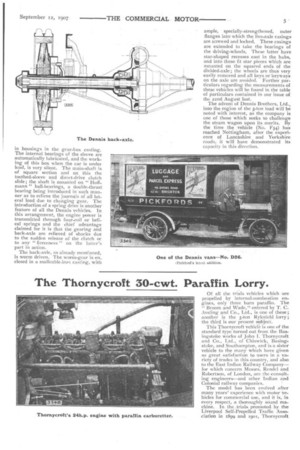The Thornycroft 50-cwt.
Page 5

Page 6

If you've noticed an error in this article please click here to report it so we can fix it.
Paraffin Lorry.
Of all the trials vehicles which are propelled by internal-combustion engines, only three burn paraffin. The Broom and Wade," entered by T. C. Aveling and Co., Ltd., is one of these ; another is the 5-ton Rykriield lorry ; the third is our present subject.
This Thornycroft vehicle is one of the standard type turned out from the Basingstoke works of John I. Thornycroft and Co., Ltd., of Chiswick, Basingstoke, and Southampton, and is a sister vehicle to the many which have given so great satisfaction to users in a variety of trades in this country, and also to the East Indian Railway Company— for which concern Messrs. Rendel and Robertson, of London, are the considting engineers—and other Indian and Colonial railway companies.
The model has been evolved after many years' experience with motor Vehicles for commercial use, and it is, in every respect, a thoroughly sound machine. In the..trials promoted by the Liverpool Self-Propelled Traffic Association in 1899 and 1901, Thornycroft
steam wagons played a very prominent part, and the experience which has been gained by this company since the most creditable performances of its vehicles during those trials, cannot fail to prove its influence in the evolution of its latest types. " Cro," as the paraffin lorry is officially styled, is the lightest vehicle in its class. Its weight, unladen, is r ton, 12 cwt., 3 qrs., but it is by no means a "flimsy" machine. It is built on a premed-steel frame of simple, yet strong, form : the two, after crossmembers are prolonged, and their ends receive the rear-spring shackles. This arrangement provides a stiff structure, with the least possible weight. The engine is one of the company's, standard,
24h.p. nattern, and it has four, separate cylinders of 41 inches in diameter, with a piston-stroke of 5 inches, but we understand that, for reasons concerning the manufacture, all future vehicles of this model will have engines of 3oh.p. fitted to them. One reason for this change, which has not been decided upon because greater engine-power is really required, is that the works' ar rangements for producing the largerpower engine are now so thorough, and the design has been so carefully tested, that it is considered advisable to standardise the type.
The engine on the vehicle in class C is fitted with one of the company's "U" tube vaporisers, the arrangement of which causes the induction air to pass through a tube of "U" formation, and to pick up the liquid fuel as it passes through a mixing valve; the mixture is vaporised by reason of the heat imparted to the U" tube by the exhaust gases which circulate through the jacket surrounding the "U" tube. The latter receives its initial heat from the exhaust gases, whilst the engine is running on petrol, but this is only for a few minutes when starting from cold.
Low-tension, magneto ignition is employed, and the timing of the spark is synchronised by means of eccentric cams, which are coupled up through levers, a connecting-link, and a cable to the hand-control lever. This arrangement may be seen in our illustration of the engine in situ on the chassis, and its function is to alter the angle of advance of the trip-levers with the actuating cams on the camshaft. The beautifully-flexible "Hele-Shaw" clutch is fitted, as illustrated on this page, in such a manner that it may be taken down without disturbance of either engine or gear-box.
The very short shafts in the gear-box are a leading feature in its design. There is practically no chatter due to whipping of the shafts, and this point greatly contributes to the silent running of the machine. We reproduce the general-arrangement drawings of the gear-box which, it will be seen, provides for three speeds forward, with direct, through drive on top gear, and one speed reverse. The top speed, with the engine running at its normal rate, is 15 miles an hour, and, on top gear, the engine is capable of ta'cing a full load of 2 tons (including the weight of the body) along all ordinary roads, and up many stiff gradients, at an average speed well up to that already named. The fuel consumption, during normal running, is very favourable, being somewhere in the region of one gallon of paraffin for each 12 miles. The final transmission is through a bevel-driven differential-shaft, and Hans Renold roller-chains of rt-inch pitch, to the rear
road-wheels. Further particulars of " C t9," as well as of " E45," the other Thornycroft vehicle, will be found in the tabulated list in our issue of the 22nd ultimo, and our 48-page trials booklet published on Saturday last.




























